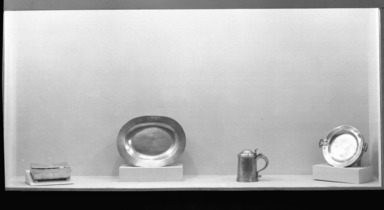

American Pewter from the John W. Poole Collection, June 01, 1945 through November 30, 1945 (Image: PHO_E1945i004.jpg Brooklyn Museum photograph, 1945)
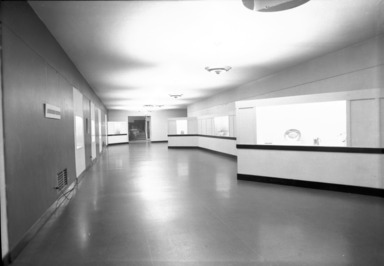
American Pewter from the John W. Poole Collection, June 01, 1945 through November 30, 1945 (Image: PHO_E1945i005.jpg Brooklyn Museum photograph, 1945)
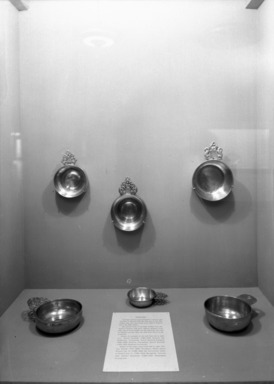
American Pewter from the John W. Poole Collection, June 01, 1945 through November 30, 1945 (Image: PHO_E1945i006.jpg Brooklyn Museum photograph, 1945)

American Pewter from the John W. Poole Collection, June 01, 1945 through November 30, 1945 (Image: PHO_E1945i007.jpg Brooklyn Museum photograph, 1945)

American Pewter from the John W. Poole Collection, June 01, 1945 through November 30, 1945 (Image: PHO_E1945i008.jpg Brooklyn Museum photograph, 1945)
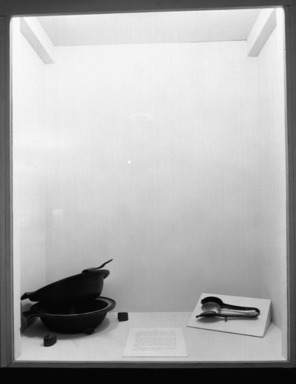
American Pewter from the John W. Poole Collection, June 01, 1945 through November 30, 1945 (Image: PHO_E1945i009.jpg Brooklyn Museum photograph, 1945)

American Pewter from the John W. Poole Collection, June 01, 1945 through November 30, 1945 (Image: PHO_E1945i010.jpg Brooklyn Museum photograph, 1945)
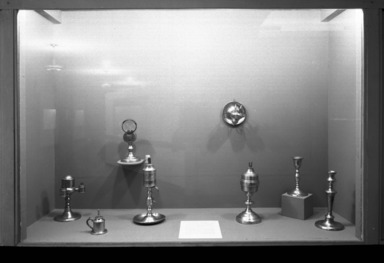
American Pewter from the John W. Poole Collection, June 01, 1945 through November 30, 1945 (Image: PHO_E1945i011.jpg Brooklyn Museum photograph, 1945)
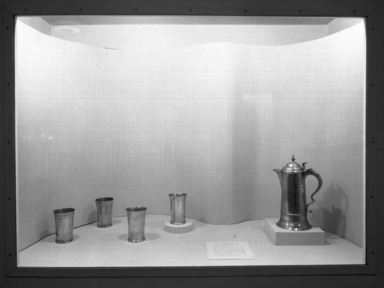
American Pewter from the John W. Poole Collection, June 01, 1945 through November 30, 1945 (Image: PHO_E1945i012.jpg Brooklyn Museum photograph, 1945)
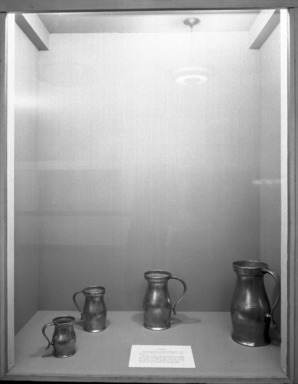
American Pewter from the John W. Poole Collection, June 01, 1945 through November 30, 1945 (Image: PHO_E1945i013.jpg Brooklyn Museum photograph, 1945)
American Pewter from the John W. Poole Collection
-
June 1, 1945
A special exhibition of American pewter, based on design and form, will open at the Brooklyn Museum on June 14 and will continue through August 19. Outstanding examples have been selected from the John W. Poole collection recently purchased by the Museum and from pieces received as gifts from other sources. The Poole collection contains two hundred and forty-six items and is one of the most comprehensive of its kind ever to be assembled by a private individual. This exhibition emphasizes the intrinsic beauty of early American pewter and illustrates by a wide variety of form its extensive use in the every-day life of America during the 18th and 19th centuries.
Surviving American pewter is considered “early” if made at the time of the Revolution or even as late as 1800. This is partly due to the fact that pewter is a soft metal and will not stand hard usage. It is estimated that the average life of a pewter plate in daily use was about five years. In colonial days the main ingredient, tin, had to be transported from England which was costly, and to discourage pewter manufacture in the colonies, England placed a high duty on the metal in bulk but not on the finished product. As a result, secondhand pewter commanded a good price. The worn or damaged pieces were readily purchased and recast into new articles.
American pewterers stamped a substantial part of their output with distinctive makers’ marks called a touch. The touch was struck on the casting after removal from the mould, leaving the imprint of the mark in relief. The designs of these marks are very interesting.
Represented in the exhibition are the five principal American pewter-making centers: Boston, Rhode Island, the Connecticut Valley, New York and Pennsylvania. Each region developed definite local variations in style and design, and featured a different type of ware. In Boston the early pewterers made only plates and basins, with the exception of a few quart mugs produced by Nathaniel Austin (1763-1807) of Charlestown, Massachusetts. An excellent marked example of one of these rare mugs will be shown.
Rhode Island is best known for its porringers which were produced in large numbers. Well-executed pieces made by Samuel Hamlin (1771-1801) and William Billings (1791-1806) are represented in the collection.
The Connecticut Valley was largely controlled by the descendants of Thomas Danforth (1727-1773) of Norwich and their associates. They made fine ecclesiastical pewter as well as a wide variety of other pieces.
The pewter produced in New York City by Frederick Bassett (1761-1800) was designed with great distinction. The flat-top tankard with a crenate lid of the type used in England at the time of Charles II, and a rare commode form attest to Bassett’s skill. Another early Now York pewterer, Henry Will (1761-1793) was a craftsman who delighted in making unusual forms. Unique pieces included by this maker are the only known oval American platter, the only marked American pewter hot-water dish and the only marked American covered writing box.
William Will of Philadelphia (1764-1796) made the earliest American pewter teapots in two distinctive forms. A small pear-shaped example of Queen Anne style is one of the oldest surviving American Pewter teapots.
American ecclesiastical pewter illustrates some of the handsomest designs that have survived. Two marked flagons and chalice by Johann Christopher Heyne (1764-1798) of Lancaster, Pennsylvania, reflect a strong continental influence, due to Heyne’s early training in Saxony. Among the most striking pieces of pewter made in this country are the chalices of American pattern produced by Peter Young (1785-1795) of Albany. Their fine form is Young’s own original design with no counterpart having been made in Europe. While the pair of chalices made by Timothy Brigden (1815-1819) of Albany follow the design of Peter Young, the carefully finished details and the fine quality of metal employed reflect Brigden’s early training as a silversmith. Other ecclesiastical pieces of exceptional form are the flagon made by T. C. & S. Boardman (1810-1850) of Hartford, and the set of communion beakers by Edward Danforth (1788-1794) of Middletown and Hartford.
Certain rare pieces in the exhibition merit special attention, not only for their fine form but because they were made at an early date. A plate made by John Carnes (1723-1763) of Boston is the only known surviving example of this maker’s work. Other items in this class are the lidless tankard produced by Benjamin Day (1744-1757) of Newport, Rhode Island, and the domed-top tankard by John Bassett (1720-1761) of New York.
In the fall the entire collection will be installed in a permanent gallery on the fourth floor, at which time a handbook will be published. This special exhibition has been assembled and arranged by John M. Graham, II, Curator of Decorative Arts.
Brooklyn Museum Archives. Records of the Department of Public Information. Press releases, 1942 - 1946. 04-06/1945, 026-8.
View Original -
August 29, 1944
AMERICAN PEWTER
Exhibition date extended through November 4, 1945
Outstanding examples selected from the John W. Poole Collection recently purchased by the Museum, and additional pieces received as gifts from other sources. This exhibition, based on design and form, emphasizes the intrinsic beauty of early American pewter and illustrates its extensive use in the everyday life of America during the 18th and 19th centuries.
LIFE ON THE MISSISSIPPI
October 5 - December 10, 1945
An exhibition of about 60 lithographs and engravings depicting the days of the flatboats, steamboats, riverpilots, and midnight races, plantations and luxury “showboats” of the Mississippi before and after the Civil War. The greater portion of the lithographs were issued by Currier and Ives and other American lithographic houses which flourished in the 19th century. The majority of the prints have been lent through the courtesy of Knox College, Galesburg, Illinois.
THE NEGRO ARTIST COMES OF AGE
PORTRAITS OF DISTINGUISHED NEGRO CITIZENS
November 2 - November 25, 1945
An exhibition of 61 paintings and sculptures, which originated at the Albany Institute of History and Art, and is now being circulated by The American Federation of Arts. A group of portraits of distinguished Negro citizens will be shown with this exhibition.
LANDSCAPE
November 8, 1945--January 1, 1946
European and American landscape painting, with loans from many museums and private collections (about 70 canvases), showing the development of both the philosophical and visual points of view towards landscape from the early fourteenth century to the present. There will be a detailed and illustrated catalogue. In connection with this large exhibition, the Museum is planning two smaller shows which will be on view at the same time: landscape water colors from the Museum collection and a group of unusual landscape photographs.
PORTRAITS OF CHILDREN
From the Museum’s Print Collection
December 14--January 6, 1946
A special Christmas exhibition of Children’s Portraits by 19th and 20th century artists, from the Museum’s Print Collection.
GOLD, SILVER and JADE
December 20 - closing date indefinite
An exhibition of rare examples from the Museum’s famous Pre-Columbian collection of gold, silver and jade, representing Central and South America, especially Mexico, Costa Rica, Panama, Colombia, and Peru. A few items will be borrowed from private collectors.
PAINTING GALLERIES RE-OPENED
January 4, 1946
Plans are being made to re-hang all painting galleries. European and American paintings, including Homer and Sargent water colors, which have been in storage for the duration, will be placed on permanent exhibition.
OUR FABRIC HERITAGE
January 15 - March 30, 1946
A three-dimensional history of textiles. The inventions and developments in all phases of textile arts and techniques, from the earliest fibers, dyes and looms to the present, will be illustrated by maps, models and materials. In connection with the exhibition there will be lectures by leading authorities on such phases of the fabric arts as the development of historical and synthetic fibers, printing and finishing of materials, and the technological skills in the field. These lectures will be for the professional public and admission will be by invitation only.
30th ANNUAL, THE BROOKLYN SOCIETY OF ARTISTS
April 17 - May 26, 1946
In keeping with established precedent, artists residing or teaching in Brooklyn will be invited to submit works in oil, water color, black and white and sculpture for selection by a jury.
Brooklyn Museum Archives. Records of the Department of Public Information. Press releases, 1942 - 1946. 07-09/1945, 051-2.
View Original
